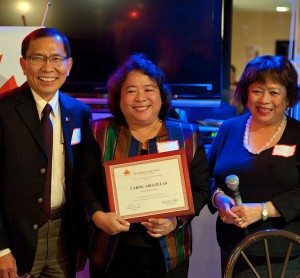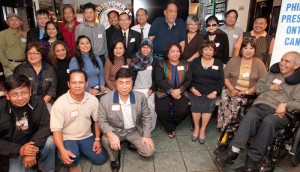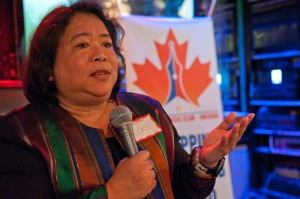Changing Mindanao, one story at a time
Changing Mindanao, one story at a time
Marshall McLuhan Journalism Awardee Carolyn O. Arguillas
When you think of Mindanao, do you think beautiful forested landscapes and a multi-cultural society with a rich pre-colonial history? Or do you think of violence and war? Probably the latter, but the 2011 winner of the Marshall McLuhan Prize is working to change these perceptions through journalism.
The Davao City-based journalist, spoke at the Toronto Reference Library on September 26 and the following night at Aristokrat Restaurant in North York about her work that garnered the prize. The Canadian Embassy in Manila awards the Marshall McLuhan Prize annually to recognize excellence in investigative journalism.
To the rest of the world, Mindanao “equals violence, equals war,” Arguillas said to the audience at the library. “But for all the bad news about Mindanao, it is paradise to us 21.5 million residents,” she said.

AWARDEE. Carolyn Arguillas, center, recipient of the 2011 McLuhan Award for Investigative Journalism, is conferred honorary membership in Philippine Press Club-Ontario at a forum held Sept. 27. At left is Consul General Pedro O. Chan, at right is PPCO acting President Rose Tijam. PHOTO: JOSEPH SMOOKE
Arguillas says a large part of why Mindanao is seen negatively is the spin that Manila-based news agencies put on stories from there, but she does not deny the reasons why others would associate the region with violence.
“Massacre is one of the dominant images of Mindanao” Arguillas said referring to the Maguindanao Massacre on November 23, 2009 in Ampatuan town. Many now associate Mindanao with this killing of 58 people, including 32 journalists.
Mindanao is home to more than half of the Philippines’ armed forces and private armies of local politicians and is the “breeding ground for the military resistance,” Arguillas said. The citizens and journalists regularly contend with anti-government groups the New People’s Army, the MILF and the MNLF.
Since the US occupation, the minority Moro and indigenous people have been struggling for self-determination, she said. It is the richest region in natural resources and has been the site of many battles between the Philippine army and government and the rebel groups.
For the national newspapers and television stations in the Philippines “Mindanao is really just a defence beat. It’s a military beat.” Arguillas said.
“We fought several battles with the central desk,” Arguillas said of her self and her colleagues at Mindanews, who have all worked for the national newspapers at one point. She said they would try to publish stories that would look for ways of reconciling the warring sides, for example in the 2000 war between the Philippine army and the MILF during their peace talks. But she said their stories would be changed into the usual “bang bang” incident of the day.

Members and guests of the Philippine Press Club-Ontario with McLuhan Awardee for Investigative Journalism Carolyn Aguillas and Congen Pedro O. Chan at the Sept. 27 forum. PHOTO: JOSEPH SMOOKE
The television crews did no better than the papers during the same war. “The firing of the canons were more telegenic than the displaced peoples,” Arguillas said of the footage of the Philippine military that was often used in favor of the coverage of the million people displaced during the conflict.
“We got sick and tired of complaining,” she told the audience, “so we set up Mindanews.” She continued, “Our main desire is to change the discourse and report on Mindanao as we know Mindanao, as we feel Mindanao.”
In 2002, they convened a group of journalists and community stakeholders, including the minority Moro and indigenous peoples and the settler populations to critique the news coverage. She said in the question period that the Moro people felt demonized and the indigenous people felt their voices were not represented.
“If you were a journalist, their comments were hurting because they spoke the truth,” she said. She realized that the work she did for decades was part of the problem. Arguillas has extensively covered the conflict and peace processes in Mindanao for the past 27 years, which included being a reporter for Veritas Magazine and the region’s bureau chief for The Philippine Daily Inquirer.
Building on the 2002 conference, she refined her work as the editor-in-chief of the daily news service, Mindanews, which she co-founded a year prior.
Mindanews and the umbrella organization Mindanao News and Information Cooperative Center (MNICC), seeks a “realistic balance of truthful reporting on the lives, initiatives, relationships, issues, dreams and triumphs of our people.” Arguillas said because she and her colleagues are major stakeholders in the peace process in Mindanao. Therefore they don’t merely disseminate news.
Since starting the daily news service of news about Mindanao, which services Philippine and international news agencies, Arguillas and her colleagues have worked in many other media. They have a monthly news magazine, an online newspaper, and have produced video documentaries, and books. They’ve also developed empowerment programs that teach displaced people their rights according to United Nations proclamations and train journalists from and about the region.
Mindanews is the primary source of many international organizations for in-depth analysis of Mindanao said the Philippine Embassy public affairs officer Carlo Figueroa in the question period at the library event. Arguillas added that Manila-based agencies regularly consult Mindanews for sources and for information “behind the headlines,” to know more about the context and consequences of events in Mindanao.
Arguillas said in an interview that colleagues in Manila are changing their coverage of the region. She said she hopes that Canadians broaden their understanding of the complexities of Mindanao’s issues.
The speaking engagements are included in the McLuhan Prize, which is awarded in conjunction with Canadian Journalists for Free Expression (CJFE), SunLife and the University of Toronto’s Faculty of Information.

Comments (5)
Categories